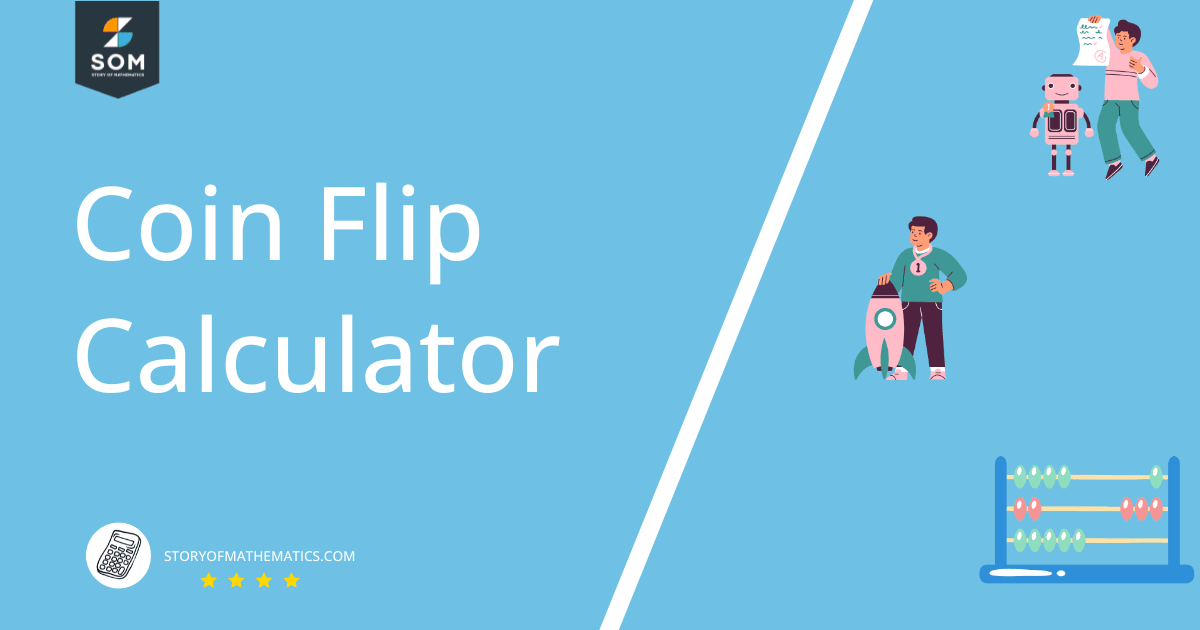JUMP TO TOPIC
Coin Flip Calculator + Online Solver With Free Steps
The Coin Flip Calculator is an online tool that determines the probability of getting exactly the ‘h’ number of heads/tails out of an ‘N’ number of coin tosses.
A Coin Toss is a standalone event, thus whether it lands heads or tails in one trial has no impact on the results of subsequent trials.

What Is a Coin Flip Calculator?
The Coin Flip Calculator is an online tool used to determine the probability of an event, which is defined as the ratio of the number of favorable outcomes to the total number of outcomes.
The probability formula for the coin toss also has an equivalent.
\[ \text{Probability} = \frac{\text{Number of favorable outcomes}}{\text{Total number of outcomes}} \]
How To Use a Coin Flip Calculator
You can use the Coin Flip Calculator by following the detailed guidelines below.
Step 1
In the input box “Provide Required Input Value:” enter the values of the probability of getting heads and the total number of trials.
Step 2
Click on the “SUBMIT” button to determine the probability of flipped coin and also the whole step-by-step solution for the Coin Flip Calculator will be displayed.
How Does a Coin Flip Calculator Work?
Coin Flip Calculator works by determining the potential outcomes of particular occurrences. It is necessary to follow a straightforward formula and use multiplication and division.
Apply the following methods to calculate the probability, which you may do for several applications that need a probability format:
- Identify a singular event that will have a singular outcome.
- Calculate all outcomes that could occur.
- Subtract the total number of possible outcomes from the number of occurrences.
Two outcomes can happen when you flip a coin: heads or tails. Each result has a set probability that remains constant from trial to trial. When flipping coins, the odds of getting heads or tails are both equal at 50%.
More frequently, there are instances where the coin is biased, resulting in varying odds for heads and tails. Subsequently, we will look at probability distributions where there are only two outcomes possible and their fixed probabilities add up to one.
These are referred to as binomial distributions.
Classical Probability
The classical possibility is a probabilistic term that quantifies the probability of an event occurring. This often indicates that every statistical experiment will have elements that are equally likely to occur (equal chances of occurrence of something).
In light of this, the concept of classical probability is the most basic sort of probability, where the odds of anything occurring are equal.
\[ \text{Probability} = \frac{\text{Number of favorable outcomes}}{\text{Total number of outcomes}} \]
As an example, consider a die roll. Six outcomes can occur while using conventional, six-faced dice, namely the numbers from 1 to 6.
The odds of each of these outcomes are the same if the die is fair, or 1 in 6 or 1/6. Thus, the likelihood of getting 6 when rolling the dice is 1/6. The likelihood is the same for either 3 or 2.
Keep in mind that an experiment’s results are more reliable the more times it is replicated. So, feel free to roll it a thousand times.
Coin Flip Probability Formula
When we flip a coin, we can get either Head (H) or Tails (T). As a result, S = {H, T} is the sample space. It is referred to as an event by each subset of a sample space.
However, the probability of the whole sample space (either Heads or Tails) is always present, whereas the chance of an empty set (neither Heads nor Tails) is always 0.
We can apply the following formula to each additional provided event E (i.e., A subset of S):
\[P(E)=\frac{\text{Number of elements in } E}{\text{Number of elements in } S}\]
Where P(E) is the possibility of an event.
Random Coin Flip
Coins that are caught have a slight predisposition to remain in the same condition as when they were thrown. On the other hand, the prejudice is hardly noticeable. Therefore, the result of tossing a coin may be regarded as random regardless of whether it is caught in midair or allowed to bounce.
Solved Examples
Let’s explore some examples to better understand the Coin Flip Calculator.
Example 1
A Coin is Tossed Thrice at Random. What is the Probability of getting
- At Least One Head
- The Same Face?
Solution
The possible outcomes of a given event are HHH, HHT, HTH, HTT, THH, THT, TTH, and TTT.
So, a total number of outcomes = 8.
Part 1
Number of favorable outcomes for event E:
\[ = \text{Number of outcomes where at least one head appears} \]
\[ = 4 \]
\[ = 4/8 \]
\[ = \frac{1}{2} \]
So, by definition: P(F) = 1/2.
Part 2
Number of favorable outcomes for event E:
\[ = \text{Number of outcomes having the same face} \]
\[ = 2 \]
\[ = \frac{2}{8} \]
\[ = \frac{1}{4} \]
So, by definition: P(F) = 1/4.
Example 2
What will be the probability of getting 4 heads in 6 coin tosses?
Solution
\[ \text{Number of trials} = n = 6 \]
\[ \text{Total possible outcomes} = 2^n = 2^6 = 64 \]
\[ \text{Number of heads} = h = 4 \]
\[ \text{Total number of favourable outcomes} = {}^{6} C_{4} = 15 \]
Now:
\[ \text{Probability} = \frac{15}{64} = 0.234 \]
Example 3
What is the probability of getting all heads when you toss a coin 4 times?
Solution
The total number of possible outcomes when a coin tosses 4 times is 2$^\mathsf{4}$ = 16.
The possibilities are HHHH, HTTT, HHTT, HHHT, HTHT, TTTT, THHH, TTHH, TTTH, TTHT, HHTH, HTHH, THTT, TTHT, HTHT, and THTH.
\[ \text{Probability formula} = \frac{\text{no. of favorable outcomes}}{\text{total number of possible outcomes}} \]
The possibility of getting all heads i.e. {HHHH} is 1/16.
